The Pericarditis Treatment Market is estimated to be valued at USD 4.1 billion in 2025 and is projected to reach USD 6.8 billion by 2035, registering a compound annual growth rate (CAGR) of 5.2% over the forecast period.
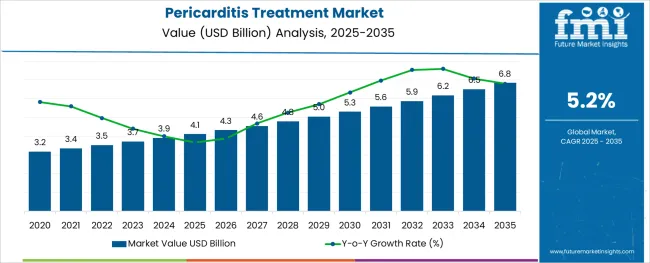
The pericarditis treatment market is gaining steady traction, driven by a growing incidence of cardiovascular conditions and increasing awareness about the early diagnosis of inflammatory heart diseases. Clinical discussions and healthcare publications have emphasized the need for timely intervention in pericarditis cases to prevent complications such as cardiac tamponade and chronic pericardial inflammation.
Therapeutic advancements have made it possible to treat both acute and recurrent pericarditis cases with greater clinical precision, improving patient outcomes. Hospitals and specialty cardiac centers are playing a vital role in the management of these conditions, providing comprehensive care through multidisciplinary teams.
Public health initiatives are also contributing to disease awareness, leading to improved treatment-seeking behavior. In the coming years, the market is expected to benefit from the introduction of targeted therapeutics, expansion of minimally invasive treatment procedures, and growing hospital infrastructure focused on cardiac care. Segmental expansion will be led by Acute Pericarditis Treatment, increased demand for Pericarditis Therapeutics, and the rising number of Pericarditis Treatments performed in Hospitals.
The market is segmented by Disease Type, Treatment Type, and End Use and region. By Disease Type, the market is divided into Acute Pericarditis Treatment, Chronic Pericarditis Treatment, Recurrent Pericarditis Treatment, and Idiopathic Pericarditis Treatment.
In terms of Treatment Type, the market is classified into Pericarditis Therapeutics, Nonsteroidal Anti-Inflammatory Drugs (NSAIDs), Antibiotic/Antifungal Medication, Corticosteroids, Pericarditis Treatment through Surgery, Pericardiectomy, Pericardiocentesis, and Pericardiotomy.
Based on End Use, the market is segmented into Pericarditis Treatment in Hospitals, Pericarditis Treatment in Clinics, Pericarditis Treatment in Ambulatory Surgical Centers, and Pericarditis Treatment in Academic & Research Institutes. Regionally, the market is classified into North America, Latin America, Western Europe, Eastern Europe, Balkan & Baltic Countries, Russia & Belarus, Central Asia, East Asia, South Asia & Pacific, and the Middle East & Africa.
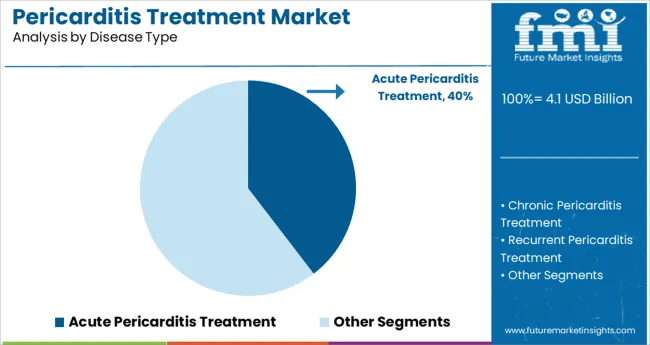
The Acute Pericarditis Treatment segment is projected to account for 39.6% the pericarditis treatment market revenue in 2025, holding a significant share among disease types. This segment has expanded as acute pericarditis remains the most frequently diagnosed form, often requiring immediate therapeutic intervention. The rising detection rates of viral and idiopathic pericarditis cases have made acute management a clinical priority.
Physicians have prioritized anti-inflammatory therapies and pain management protocols to address the sudden onset of symptoms in acute cases. The availability of standardized treatment guidelines has also contributed to consistent treatment practices across healthcare settings.
Acute cases often require hospitalization, further reinforcing the segment’s role in market revenue. With patient outcomes closely linked to the timely administration of therapies, the Acute Pericarditis Treatment segment is expected to retain a strong foothold in the market.
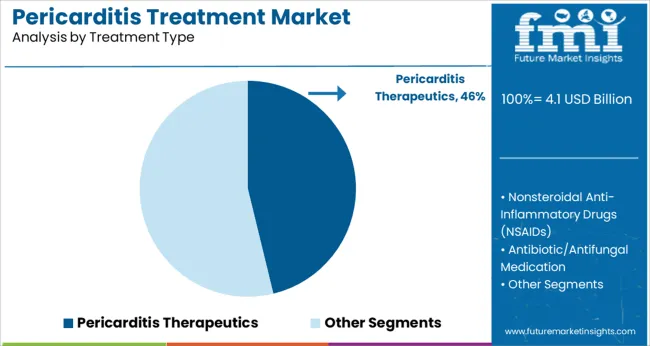
The Pericarditis Therapeutics segment is projected to hold 46.2% the market revenue in 2025, making it the leading treatment type. This growth has been supported by the rising use of drug therapies aimed at reducing inflammation and preventing recurrence. Anti-inflammatory agents, colchicine, and corticosteroids have remained key components of therapeutic regimens for both acute and chronic cases.
Healthcare providers have emphasized pharmacological treatment as a first-line approach before considering invasive procedures. The increased understanding of the autoimmune aspects of pericarditis has guided the development of more targeted therapeutic approaches.
Additionally, advancements in outpatient care have enabled the wider administration of oral therapeutics, improving patient adherence. As clinical focus continues to evolve toward early symptom control and long-term disease management, the Pericarditis Therapeutics segment is expected to sustain its growth momentum.
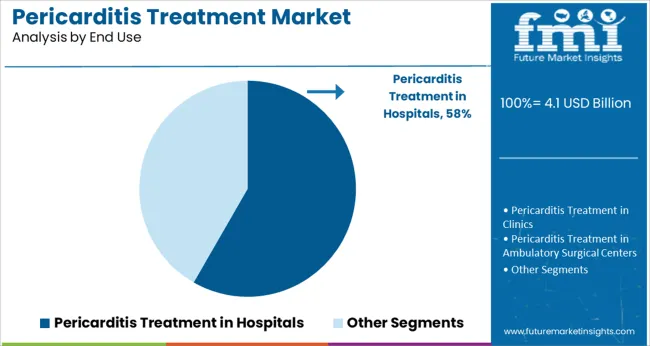
The Pericarditis Treatment in Hospitals segment is projected to contribute 58.3% the market revenue in 2025, maintaining its leadership in end-use settings. Growth of this segment has been driven by the complexity of managing moderate to severe cases, which require hospitalization for intensive monitoring and care.
Hospitals have provided the infrastructure necessary for advanced imaging diagnostics and the management of potential complications like effusion or tamponade. Multidisciplinary teams within hospital settings have been essential in delivering coordinated care involving cardiology, infectious disease, and rheumatology specialists.
Inpatient protocols have facilitated faster treatment initiation and monitoring of therapeutic response, contributing to improved patient outcomes. With hospitals continuing to serve as the primary centers for cardiac emergencies and specialized interventions, the Pericarditis Treatment in Hospitals segment is expected to maintain its dominant market share.
The rising prevalence of cardiovascular diseases around the world is a major growth driver for the Global Pericarditis Treatment Market. The growing geriatric population has also been influencing the pericarditis treatment market. Acute pericarditis is the most common disease in several clinical settings, according to Cureus, an open access medical journal for a new generation of doctors and patients.
Acute pericarditis has been reported to affect between 0.1 and 0.2% of hospitalized patients, with 5% of patients admitted to the emergency department with non-ischemic chest pain. Furthermore, cardiovascular diseases kill 17.9 million people worldwide each year, accounting for an estimated 31% of all deaths.
Low- and middle-income countries account for more than 75% of cardiovascular deaths. The use of dual therapy to treat idiopathic pericarditis is a major factor driving the global pericarditis treatment market. Aspirin is traditionally used as a monotherapy to treat acute pericarditis.
Furthermore, increased smoking, alcohol consumption, and lifestyle changes are major contributors to the rise in cardiovascular diseases, as well as the pericarditis treatment market. More emphasis on the prevention and treatment of cardiovascular diseases in low- and middle-income countries is expected to drive the growth of the Pericarditis treatment market.
As a result of the increased prevalence of idiopathic pericarditis with repeated episodes, the use of dual therapy, such as aspirin with colchicine, is expected to rise. Aspirin is traditionally used as a monotherapy to treat acute pericarditis.
However, clinical trials for dual therapy with the combination of two drugs - aspirin and colchicine - for the treatment of pericarditis are underway. When compared to conventional monotherapy, the results show that combination therapy is more effective in reducing pericarditis recurrence.
As a result of the increased prevalence of idiopathic pericarditis with repeated episodes, the use of dual therapy, such as aspirin with colchicine, is expected to rise. However, the presence of misbranded drugs, surgical intervention, and stringent government rules and regulations are expected to impede the growth of the global pericarditis drugs market in the upcoming years. Moreover, rising healthcare costs are also expected to drive the global pericarditis treatment market.
Because of its large population and high prevalence of cardiovascular diseases, Asia Pacific is expected to have a significant revenue share in the global pericarditis treatment market.
The Asia Pacific pericarditis treatment market is anticipated to expand rapidly during the forecast period, owing to an increase in the number of cardiac surgeries, an uptick in patients with cardiovascular disorders, and broadening health care infrastructure.
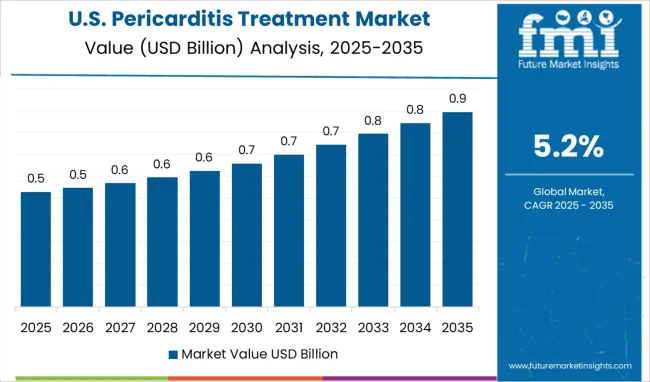
According to Future Market Insights, owing to its large network of medical and high-quality healthcare infrastructure, North America is expected to hold the largest share of the Pericarditis Treatment Market. Because North America has a large number of clinical research laboratories, it is anticipated to spur pericarditis treatment market.
Furthermore, this is due to the increasing amount of people diagnosed with cardiac disorders, as well as significant R&D and health-care spending. Furthermore, increased awareness of cardiovascular disorders is expected to drive market growth in North America.
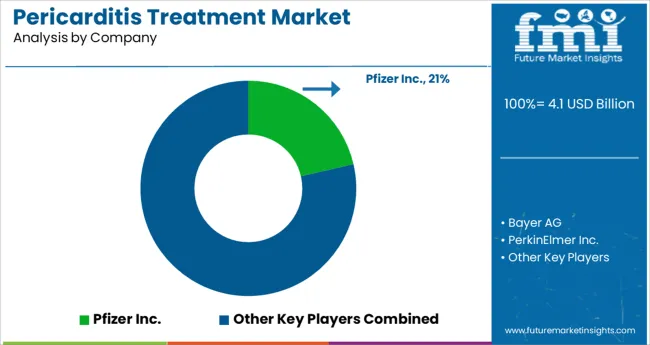
Some of the key participants present in the global Pericarditis Treatment market include Pfizer Inc., Bayer AG, PerkinElmer Inc., ALLERGAN, Lincoln Pharmaceuticals Ltd., Unicure India Pvt. Ltd., Zydus Cadila Healthcare Ltd., Twilight Mercantiles Pvt. Ltd., Aasraw Biochemical Technology Co.ltd, Sun Pharmaceutical Industries Ltd. among others.
As a result of the presence of a larger number of international and local players, the worldwide pericarditis drugs market is moderately competitive.
| Report Attribute | Details |
|---|---|
| Growth Rate | CAGR of 5.24% from 2025 to 2035 |
| Market Value for 2025 | USD 3.6 Billion |
| Market Value for 2035 | USD 6 Billion |
| Base Year for Estimation | 2024 |
| Historical Data | 2020 to 2024 |
| Forecast Period | 2025 to 2035 |
| Quantitative Units | Revenue in million and CAGR from 2025 to 2035 |
| Report Coverage | Revenue Forecast, Volume Forecast, Company Ranking, Competitive Landscape, Growth Factors, Trends and Pricing Analysis |
| Segments Covered | Disease Type, Treatment, End User, Region |
| Regions Covered | North America; Latin America; Europe; East Asia; South Asia & Pacific; Middle East and Africa |
| Key Countries Profiled | USA, Canada, Mexico, Brazil, Germany, Italy, France, UK, Spain, BENELUX, Russia, China, Japan, South Korea, India, ASEAN, Australia & New Zealand, GCC, Turkey, South Africa |
| Key Companies Profiled | Pfizer Inc.; Bayer AG; PerkinElmer Inc.; ALLERGAN; Lincoln Pharmaceuticals Ltd.; Unicure India Pvt. Ltd.; Zydus Cadila Healthcare Ltd.; Aasraw Biochemical Technology Co. Ltd.; Sun Pharmaceutical Industries Ltd. |
| Customization | Available Upon Request |
The global pericarditis treatment market is estimated to be valued at USD 4.1 billion in 2025.
It is projected to reach USD 6.8 billion by 2035.
The market is expected to grow at a 5.2% CAGR between 2025 and 2035.
The key product types are acute pericarditis treatment, chronic pericarditis treatment, recurrent pericarditis treatment and idiopathic pericarditis treatment.
pericarditis therapeutics segment is expected to dominate with a 46.2% industry share in 2025.






Our Research Products

The "Full Research Suite" delivers actionable market intel, deep dives on markets or technologies, so clients act faster, cut risk, and unlock growth.

The Leaderboard benchmarks and ranks top vendors, classifying them as Established Leaders, Leading Challengers, or Disruptors & Challengers.

Locates where complements amplify value and substitutes erode it, forecasting net impact by horizon

We deliver granular, decision-grade intel: market sizing, 5-year forecasts, pricing, adoption, usage, revenue, and operational KPIs—plus competitor tracking, regulation, and value chains—across 60 countries broadly.

Spot the shifts before they hit your P&L. We track inflection points, adoption curves, pricing moves, and ecosystem plays to show where demand is heading, why it is changing, and what to do next across high-growth markets and disruptive tech

Real-time reads of user behavior. We track shifting priorities, perceptions of today’s and next-gen services, and provider experience, then pace how fast tech moves from trial to adoption, blending buyer, consumer, and channel inputs with social signals (#WhySwitch, #UX).

Partner with our analyst team to build a custom report designed around your business priorities. From analysing market trends to assessing competitors or crafting bespoke datasets, we tailor insights to your needs.
Supplier Intelligence
Discovery & Profiling
Capacity & Footprint
Performance & Risk
Compliance & Governance
Commercial Readiness
Who Supplies Whom
Scorecards & Shortlists
Playbooks & Docs
Category Intelligence
Definition & Scope
Demand & Use Cases
Cost Drivers
Market Structure
Supply Chain Map
Trade & Policy
Operating Norms
Deliverables
Buyer Intelligence
Account Basics
Spend & Scope
Procurement Model
Vendor Requirements
Terms & Policies
Entry Strategy
Pain Points & Triggers
Outputs
Pricing Analysis
Benchmarks
Trends
Should-Cost
Indexation
Landed Cost
Commercial Terms
Deliverables
Brand Analysis
Positioning & Value Prop
Share & Presence
Customer Evidence
Go-to-Market
Digital & Reputation
Compliance & Trust
KPIs & Gaps
Outputs
Full Research Suite comprises of:
Market outlook & trends analysis
Interviews & case studies
Strategic recommendations
Vendor profiles & capabilities analysis
5-year forecasts
8 regions and 60+ country-level data splits
Market segment data splits
12 months of continuous data updates
DELIVERED AS:
PDF EXCEL ONLINE
Treatment-Resistant Hypertension Management Market Size and Share Forecast Outlook 2025 to 2035
Treatment-Resistant Depression Treatment Market Size and Share Forecast Outlook 2025 to 2035
Treatment Pumps Market Insights Growth & Demand Forecast 2025 to 2035
Pretreatment Coatings Market Size and Share Forecast Outlook 2025 to 2035
Air Treatment Ozone Generator Market Size and Share Forecast Outlook 2025 to 2035
CNS Treatment and Therapy Market Insights - Trends & Growth Forecast 2025 to 2035
Seed Treatment Materials Market Size and Share Forecast Outlook 2025 to 2035
Acne Treatment Solutions Market Size and Share Forecast Outlook 2025 to 2035
Scar Treatment Market Overview - Growth & Demand Forecast 2025 to 2035
Soil Treatment Chemicals Market
Water Treatment System Market Size and Share Forecast Outlook 2025 to 2035
Water Treatment Chemical Market Size and Share Forecast Outlook 2025 to 2035
Algae Treatment Chemical Market Forecast and Outlook 2025 to 2035
Water Treatment Market Size and Share Forecast Outlook 2025 to 2035
Water Treatment Ozone Generator Market Size and Share Forecast Outlook 2025 to 2035
Water Treatment Equipment Market Size and Share Forecast Outlook 2025 to 2035
Burns Treatment Market Overview – Growth, Demand & Forecast 2025 to 2035
CRBSI Treatment Market Insights - Growth, Trends & Forecast 2025 to 2035
Water Treatment Polymers Market Growth & Demand 2025 to 2035
Asthma Treatment Market Forecast and Outlook 2025 to 2035

Thank you!
You will receive an email from our Business Development Manager. Please be sure to check your SPAM/JUNK folder too.
Chat With
MaRIA